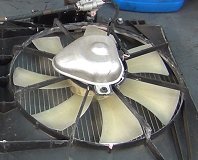You made no mention of your mechanic checking the water pump for proper operation. Before doing any of the things you listed, the mechanic was supposed to check the system for flow. Not only would this have verified if your water pump was working, it would've also showed if the system was flowing and not clogged. Which of course would've eliminated the need to remove/replace the radiator/hoses/etc.
Now, I'll just assume the mechanic DID check the water pump (He's extremely incompetent if he didn't). And from my experience, I believe you have a blown head gasket.
What usually fools an inexperienced mechanic, is they only look at the engine's oil to check for a blown head gasket. (On older cars, a blown head gasket would've turned the oil a white, milkshake like color)
But most newer cars a reverse flow and the engine blocks are designed different. So when a head gasket blows, exhaust gases get blown into the cooling system while the engine is under load (driving). This causes air to get trapped inside the radiator and heater core, which in turn prevents you coolant from circulating. (Your overheating issue)
Then when the engine is shut off, the pressure from the cooling system forces the coolant to leak into the cylinder closest to the blown part of the head gasket. The coolant will sit in that cylinder until you start the car, when it will quickly turn to steam and exit the tail pipe.
You'll only detect this steam at the first 2-5 minutes after start up. Then you won't see it anymore. And no coolant will ever leak on the ground or in the oil.
Now, without tools, you can quickly verify that this is your problem.
Remove the surge tank cap and start your motor. Throttle the engine to at least 1,500 r.P.M.S while watching the coolant in the surge tank. If you see bubbles, that's the exhaust gases from the blown head gasket. (Make sure to LOOK as you're reving the motor, because the bubbles will come and go quickly)
Another symptom of a blown head gasket:
With your engine fully warm, turn on your heater controls to full "HOT" and the fan on high. If you're getting cold or luke warm air while your engine is idling, but the air gets hot as you floor the gas pedal, then you have a blown head gasket.
The reason this is happening is:
Those exhaust gases are clogging up your heater core and stopping the coolant from circulating (Where your heat comes from). But as you rev the motor, the water pump is spinning fast enough to force the bubbles out of the way. So you get heat.
I know this isn't what you want to hear, but I deal with these issues almost every day. And I have over 15-years experience.
Either way, I hope I helped solve your problem. And if I have, please vote for me, as I'm using this to pay my bills. THANX!
SPONSORED LINKS
Friday, January 22nd, 2010 AT 12:29 AM



